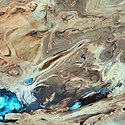Dašt-e Kavír

Dašt-e Kavír (persky دشت كوير, známá také jako Kavír-e Namak nebo Velká solná poušť) je největší íránská poušť. Je dlouhá přibližně 800 km a široká 320 km, její rozloha je cca 77 600 km². Táhne se od pohoří Elborz na severozápadě až k poušti Dašt-e Lút na jihovýchodě a administrativně tvoří část íránských provincií Chorásán, Semnán, Teherán, Isfahán a Jazd.
Klimatické podmínky
Oblast, kde se poušť nachází, je velmi suchá. Letní teploty dosahují až 50 °C, průměrné zimní teploty se pohybují okolo 20-22 °C, ale v extrémech mohou klesat hluboko pod bod mrazu.[zdroj?]
Externí odkazy
 Obrázky, zvuky či videa k tématu Dašt-e Kavír na Wikimedia Commons
Obrázky, zvuky či videa k tématu Dašt-e Kavír na Wikimedia Commons
Média použitá na této stránce
A satellite picture of the Dasht-e Kavir desert in Iran.
The patterns you see are formed by different geological layers that have been eroded over thousands of years by wind and sometimes (but not often) rain.
The patterns are formed from either horizontal geological layers cut through by topographic changes, or geological formations (folds, domes, etc) in relatively flat terrain.
Most of the colours are due to chemical differences in the rocks, whilst the intense blue colours could be due to a range of materials, possibly salt deposits, possibly vegetation, depending on which area of the EM spectrum is represented by blue. I suspect (but don't know, the satellite bands to displayed colours are not mentioned) that the blue colours are salt deposits, but they could equally be other materials too. To be certain, knowledge of the bands to display colours is essential.
The black line running horizontally across the image is a sensor drop-out and the data for that line or lines has been irrevocably lost. The linear (but not straight) line running vertically down the middle left is a road.
USGS/NASA description: The Dasht-e Kevir, or Great Salt Desert, is the largest desert in Iran. It is primarily uninhabited wasteland, composed of mud and salt marshes covered with crusts of salt that protect the meager moisture from completely evaporating. This image was acquired by Landsat 7’s Enhanced Thematic Mapper plus (ETM+) sensor on October 24, 2000. This is a false-color composite image made using infrared, green, and red wavelengths. The image has also been sharpened using the sensor’s panchromatic band.